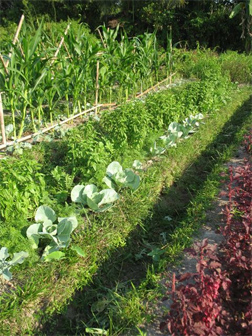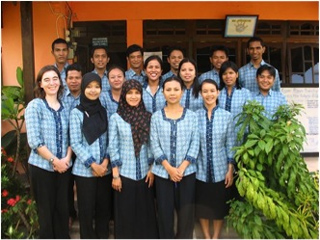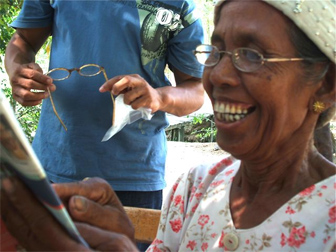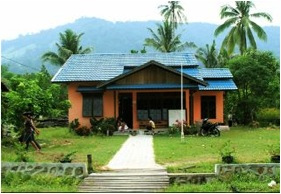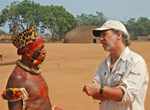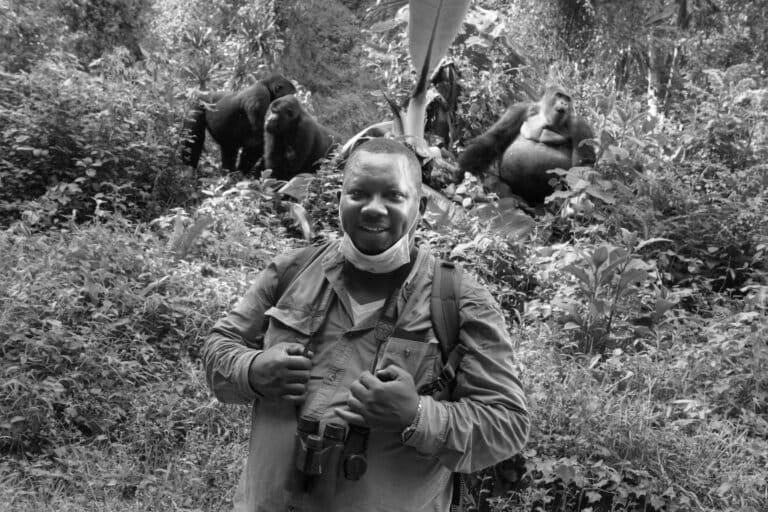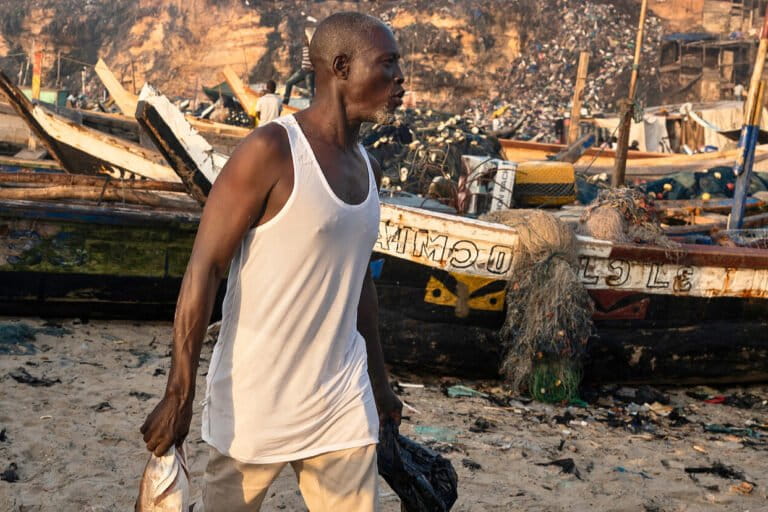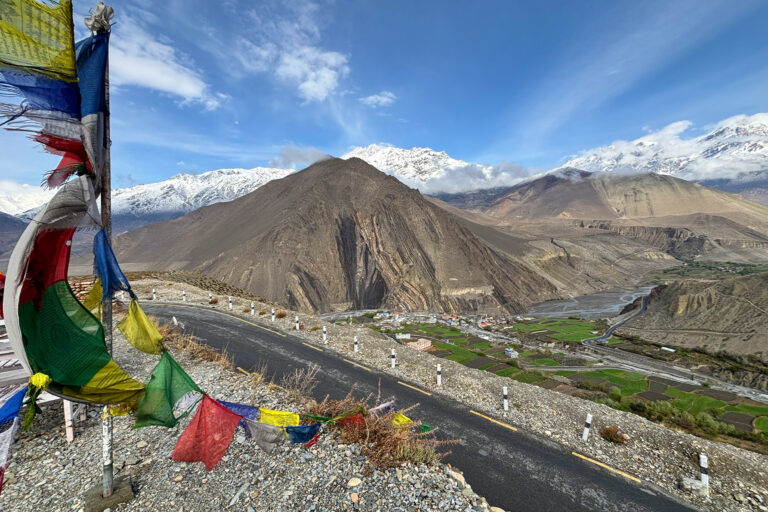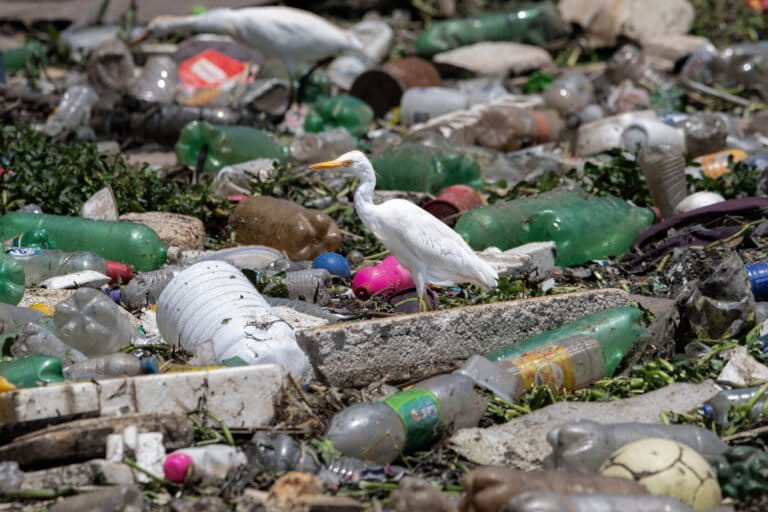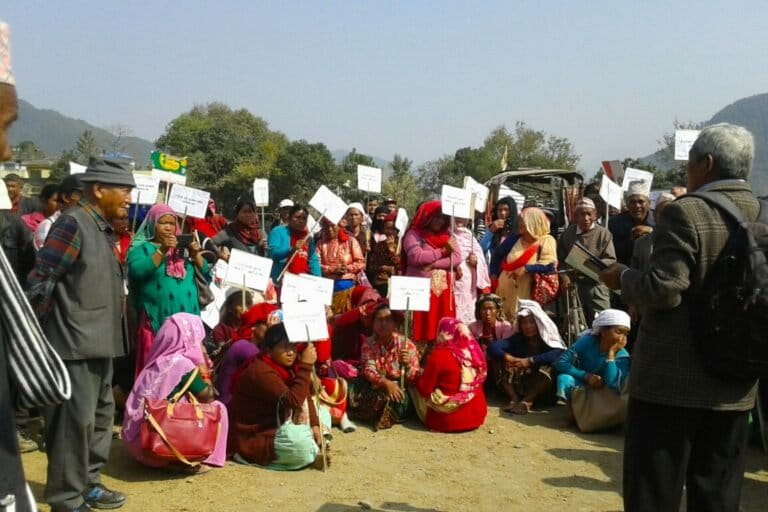Mongabay grants annual award to Health In Harmony:
Linking rural health care to forest conservation proving a success in Borneo
Rhett A Butler, mongabay.com
December 8, 2008
Health In Harmony [donate] wins mongabay.com's annual "Innovation in Conservation" award for its work to link conservation to rural healthcare. Mongabay.com's "Innovation in Conservation Award" is granted each year to an organization using an unconventional and highly effective approach to conserving rainforests and biodiversity.
Health In Harmony [donate] was today awarded mongabay.com's annual "Innovation in Conservation" award for its unique approach to conservation which combats illegal logging by providing healthcare and sustainable livelihoods to communities living around Gunung Palung National Park in Kalimantan, on the island of Borneo. The award includes a cash grant and prominent placement on the mongabay.com web site and newsletter for the month of December.
"Health In Harmony is delighted to receive this award!" said Brita Johnson, Executive Director of Health In Harmony. "Our work to preserve forests and protect human health in Indonesia is rooted in a belief that human and environmental well-being are inextricably linked – and our success is the product of unique partnerships. We're honored by mongabay.com's support and partnership, in the form of the Innovation in Conservation Award, and we're grateful for mongabay.com's work to spread the word about rainforest conservation issues."
Health In Harmony and Gunung Palung National Park
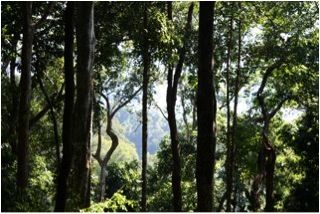
Gunung Palung National Park still contains pristine rainforest, and unimaginable biodiversity; although the park service is committed to protecting the park from illegal logging, the park is still at great risk, as there are few viable economic alternatives for local inhabitants to alleviate desperate poverty. Health In Harmony supports the ASRI program in providing alternatives to illegal logging, in the form of affordable healthcare, healthcare incentives, and conservation-oriented alternative livelihoods. |
Located in West Kalimantan, the 90,000-hectare Gunung Palung is comprised of diverse array of habitats including mangrove forests, peat swamps, montane forests, and lowland Dipterocarp forests, a type of forest that is increasingly rare in Borneo due to industrial logging and conversion to oil palm plantations. It is one of the few places on Earth where orangutans can still be observed in the wild.
But Gunung Palung has barely escaped the fate of other Bornean lowland forests. Illegal logging, encroachment, and escaped agricultural fires from neighboring plantations continue to chew away at its edges (including nearly 40 percent of its lowland area) and much of the reserve's buffer zone has now been destroyed. Gunung Palung is increasingly an island in a deforested landscape.
The loss of forest cover is affecting more than flora and fauna — local people are dependent on forests for food, building materials, and jobs. As forests disappear, life gets harder for these already impoverished communities, many of which lack access to the most basic healthcare. The work that is available is often in illegal logging, for which they earn a pittance and further depletes their resource base.
Health In Harmony is working to break this cycle by offering healthcare rewards to encourage the villagers to protect the national park, rather than log it. The effort seems to be paying off: since launching a 'forests-for-healthcare' incentive program in September, 18 of 21 communities have signed a memorandum of understanding with Health In Harmony's local partner Alam Sehat Lestari (ASRI) agreeing to participate. ASRI has also established an alternative work program whereby anyone who cannot pay cash at the ASRI clinic can instead work on conservation-promoting projects, including an organic farm and seedling nursery, which is growing trees to be used in reforestation efforts.
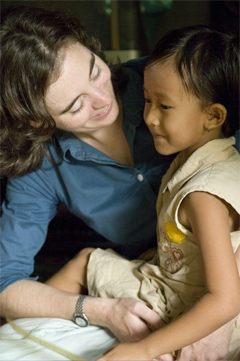
Dr. Kinari Webb, the founder of Health In Harmony, with a young patient. Dr. Webb oversees the day-to-day operations of Clinic ASRI, and acts in a teaching capacity to Indonesian physicians who provide care to the clinic’s thousands of patients. Photo credit: Erick Danzer, erickdanzer.com |
Dr. Kinari Webb, a medical doctor who founded Health In Harmony after working with orangutans in Gunung Palung, says that linking healthcare to conservation in poor areas is an effective model that could be applied beyond Borneo.
"In the area of Gunung Palung National Park, environmental destruction is strongly linked to poverty and poor health in local communities. Most people have little or no access to good healthcare or are unable to pay for treatment. Out of economic need, many communities participate directly in illegal logging or allow outsiders to log within the park near their villages. The destruction of the national park perpetuates the cycle that links poverty, poor health, and forest loss in the region by destroying an important watershed, resulting in floods, and likely by increasing rates of malaria and other illnesses."
"We believe that healthcare incentives, as well as conservation-promoting work opportunities, provide an excellent, powerful means to break the cycle that links poverty, poor health, and environmental destruction around Gunung Palung," she continued. "Health In Harmony's long-term goal is that the ASRI model be replicated in other areas where natural areas are under siege and local communities feel the negative effects of environmental destruction. Our vision is that planetary health will be improved and protected if the Alam Sehat Lestari model is employed around the world."
Webb discussed Health In Harmony in greater detail in a December 2008 interview with mongabay.com, a leading conservation and environmental science news site.
AN INTERVIEW WITH DR. KINARAI WEB
Mongabay: What initially led you to Borneo? Why did you decide to return?

Dr. Kinari Webb with a young patient. Photo credit: Erick Danzer, erickdanzer.com |
Kinari Webb: I first came to Borneo 15 years ago to study orangutans. I lived and worked for a year at a remote field station with two American and 11 Indonesian colleagues. The long solitary days in the forest while following orangutans combined with the powerful experience of seeing what life was like for the local villagers, made me question my goals of studying pure science. Even back then the sound of chainsaws in the distance was a powerful reminder that the Eden in which we lived would soon be gone and that the desperately poor villagers had few choices other than to work in illegal logging. One day one of my Indonesian colleagues cut his hand on his bush knife. While it was a moderately bad cut, I was profoundly shocked to see the fear of death in his eyes. Slowly I realized that for him, this actually was a life-threatening injury. In his village there were no antibiotics, he had never had a tetanus shot and only there in the forest was the water crystal clear and safe for washing a wound. This experience and many others opened my eyes to how much improved health care was needed in Indonesia and how important it was to also have a healthy environment. I also came to realize how privileged I had been in life despite the fact that in the US my family was classified as low-income. This experience changed my life and made me decide to pursue a degree in medicine in order to return to Indonesia and work in a very hands-on way with Indonesians to improve health care and protect the long-term well-being of the planet by protecting the rain forest.
Mongabay: How much forest remains in the areas where you work?
Kinari Webb: Our project is based in Sukadana, a small village in southwestern Borneo that lies on the coast, between the South China Sea and a national park called Gunung Palung. In that small corner of Borneo, there is little intact forest outside of the national park and a few small government forestry reserves.
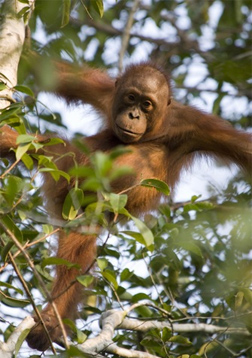
Gunung Palung National Park is home to one of the globe’s last breeding populations of wild orangutans. The ASRI program works to stop illegal logging that puts this fragile population at even greater risk. Photo credit: Erick Danzer, erickdanzer.com |
Gunung Palung National Park, a 90,000 hectare protected area in southwest Borneo, is a critically important stronghold for the country's remaining orangutan populations and a valuable conservation area for other animals and plants. The park is home to a natural, breeding population of approximately 2,500 individuals estimated to represent 5-10% of the total remaining number of orangutans. The park is also home to a wide variety of other rare and endangered animals, including agile gibbons, clouded leopards, palm civets, crested fireback pheasants, great argus pheasants, and eight species of hornbills. Within the boundaries of the protected area is also a rich diversity of habitats, including threatened peat swamp forest and lowland dipterocarp forest. In addition, the park comprises a watershed that is the major source of water for agriculture and human consumption in surrounding communities.
Gunung Palung, too, has suffered its share of damage. Between 1988 and 2002, 38% of Gunung Palung's lowlands were badly damaged with the worst destruction taking place along the perimeter of the park.
The areas outside of the park are settlements, gardens, rice fields, invasive alang-alang grasslands, oil palm plantations, or forests slated for oil palm development.
Mongabay: Is the forestry sector presently a major source of employment? What do most people do for a living in the area?
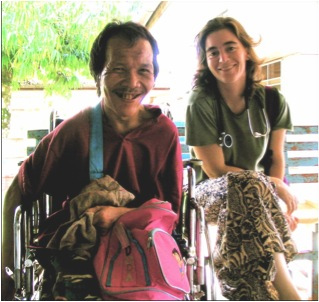
Dr. Kinari Webb, Health In Harmony founder, with a Clinic ASRI patient. Photo credit: ASRI staff |
Kinari Webb: Illegal logging is an important source of income to local people. In a survey that sampled nine villages representing locations around Gunung Palung National Park, 41% of the 234 households surveyed admitted to being involved in illegal logging. (We expect the true number is considerably higher.) Of these logging households, 77% make more than one-half of their income from logging. The average economic benefit is small though, and well below the World Health Organization's standard of absolute poverty at $1/day; logging households make on average $310/year from logging. That money is also divided among many people.
Other economic opportunities are few. Some people, women in particular, break rocks by hand for road construction. Their pay is dismal. Others – men – work for oil palm plantations that are slowly encircling Gunung Palung National Park. That work, too, is hard and low-paying. Many people farm, mostly for subsistence.
The communities bordering Gunung Palung National Park are extremely poor – the average income in the villages near the park is $13 per month.
Mongabay: How does Health In Harmony work? What led you to believe that it would be an effective conservation model?
Kinari Webb: I believe that the key to protecting human health around the world is recognizing and guarding the important link between human and environmental health at the local level. The current goal of Health In Harmony is to support Alam Sehat Lestari (ASRI), a program that works toward this goal in the communities that surround Gunung Palung National Park in West Kalimantan, Indonesian Borneo.
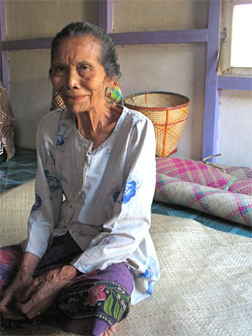
Clinic ASRI patients can trade handmade baskets and tikars (mats) for their care at Clinic ASRI. Photo credit: ASRI staff
he ASRI program’s organic farm offers work-trade opportunities to Clinic ASRI patients, provides vegetables for clinic staff and in-patients, and is a learning ground for patients and their families who want to adopt principles of organic farming at home. The organic farm also features a seedling nursery that is growing rainforest plants for the planned ASRI reforestation project. Photo credit: ASRI staff |
In the area of Gunung Palung National Park, environmental destruction is strongly linked to poverty and poor health in local communities. Most people have little or no access to good healthcare or are unable to pay for treatment. Out of economic need, many communities participate directly in illegal logging or allow outsiders to log within the park near their villages. The destruction of the national park perpetuates the cycle that links poverty, poor health, and forest loss in the region by destroying an important watershed, resulting in floods, and likely by increasing rates of malaria and other illnesses.
We believe that healthcare incentives, as well as conservation-promoting work opportunities, provide an excellent, powerful means to break the cycle that links poverty, poor health, and environmental destruction around Gunung Palung. In June 2007, Health In Harmony enabled the establishment of the Alam Sehat Lestari program in West Kalimantan. ASRI opened a health clinic in Sukadana, a coastal village on the border of Gunung Palung National Park. Since that time, the clinic has seen over 6,000 patients, established a DOTS program to treat TB in villages around Gunung Palung, launched a fast-track program to dispense birth control to women in the communities, created an ophthalmology program that has already dispensed free secondhand eyeglasses to over 1,000 villagers, initiated a program to fight malaria by distributing treated mosquito nets, and provided training courses to local doctors to improve local medical capacity.
Since the start of the program in mid-2007, the ASRI team has worked with local communities in the 21 desa (counties) surrounding the park to identify additional healthcare rewards that might encourage the villagers to protect the national park, rather than log it. Based on the outcome of participatory community workshops around the park, the rewards include monthly mobile clinic visits and discounted ambulance and clinic service. During a three month trial of the incentive system, we saw an enormous decrease in the number of desa involved in illegal logging in response to our healthcare program (see below).
In addition to the incentive system, ASRI's conservation team has established an alternative work program: anyone who cannot pay cash at the ASRI clinic can instead work on conservation-promoting projects, including the ASRI organic farm and seedling nursery, which is growing trees to be used in reforestation efforts. Also, Health In Harmony received funding in 2008 and is currently working to find carbon finance for its reforestation program; these funds might either pay directly for reforestation work, or fund healthcare, which patients and their families could pay for by participating in reforestation efforts.
Health In Harmony's long-term goal is that the ASRI model be replicated in other areas where natural areas are under siege and local communities feel the negative effects of environmental destruction. Our vision is that planetary health will be improved and protected if the Alam Sehat Lestari model is employed around the world.
Mongabay: What kind of results are you seeing?
|
Clinic ASRI staff includes 2 doctors, 5 nurses, dentist, clinic manager, DOTS program manager, pharmacist, receptionist, conservation coordinator, organic farm manager, seedling nursery coordinator, clinic cook, driver and security guard. Western medical volunteers are frequently on-site, participating in knowledge-exchange with their Indonesian counterparts. In addition, a team of 16 local DOTS (directly observed short-course therapy) workers, hired and trained from local villages, travels to tuberculosis patients’ homes to ensure that patients complete the full course of TB medications. Photo credit: ASRI staff |
Kinari Webb: ASRI recently kicked off its healthcare incentives program to promote conservation of Gunung Palung's forests. For each month that a desa (county) does not allow illegal logging in the region of the park adjacent to their lands, the following month it receives the healthcare rewards designed in our participatory community meetings (clinic discounts, ambulance service, and regular mobile clinic visits). To date, 18 of the 21 desa around the national park have signed an MOU with ASRI agreeing to participate in the incentive system; in the MOU, signatory desa promise to work toward park protection, and ASRI promises to deliver incentives on a monthly basis to communities that stop logging.
In mid-September to mid-October 2008, ASRI provided the healthcare rewards to all communities around the park, regardless of their illegal logging status. This tactic served to demonstrate up front to local people what benefits they would receive for being “green” (i.e., no logging) and what benefits they would forsake in being “red” (i.e., logging in the park).
Mid-October to mid-December represented a trial of the incentive system that is still in progress. National park staff reported to ASRI in the middle of each month on the “red-green” status of each desa during the previous month. The results so far are shown in the table below:
|
|
During the first month shown in the table above (mid-September to mid-October), all of the desa reported to us by the park office had a status of “red” – all had been involved in illegal logging within the national park during the previous month. Data for ten desa were not reported to us, representing a need to form stronger relations with the park office to ensure data collection and reporting. In the second month (mid-October to mid-November), five desa were reported as “green”, including three that had been “red” the month before. Sejahtera and Mata-mata are communities that are particularly heavily involved in illegal logging; their conversion from “red” to “green” was noteworthy. In the third month (mid-November to mid-December), we saw a radical increase in the number of “green” villages – a total of ten had not engaged in logging the previous month. We will begin to provide the incentive involving discounted ambulance service in December, when ASRI's new 4WD ambulance will be ready for pickup.
We are extremely pleased with the apparent conversion of several “red” communities to “green”. Over the next six months, ASRI will make a major effort to do community outreach that will help us (1) find incentives that motivate “red” communities to go “green”, (2) maintain incentives to keep “green” communities “green”, and (3) promote our seedling collection and reforestation work as a means for local people to pay for healthcare in the ASRI clinic.
Mongabay: Are local authorities supportive of your efforts?
Kinari Webb: The national park office has been extremely supportive. The park director, Pak Anto, has worked hard with us to help design the incentive system and to establish a system for ASRI to receive monthly “red-green” status reports from his field officers. None of ASRI's work would be possible without support from the park office.
The local departments of health in the two districts in which we work have also been wonderfully supportive and have asked us to do monthly training of staff in the surrounding government health clinics. We have a strong relationship and are continuing to find ways to work together.
Mongabay: Do villagers recognize the importance of using forest resources sustainably? Is unsustainable use mostly a result of necessity?
Kinari Webb: As floods become more common in villages downstream from logged parts of Gunung Palung, yes, there is an emerging awareness that unchecked logging is causing some big local problems. One such local village was settled at its current location because the spot was just above the tidal zone on a big river. With decreased flow of water from the logged areas upstream, the village now only has access to salty water for much of the year and must purchase freshwater for drinking. People there have become very aware that this problem has arisen because of rampant illegal logging.
|
Eyeglasses, donated by the Lions Club and individual donors, bring delight to their recipients. Distribution of eyeglasses is a feature of Clinic ASRI mobile clinic visits, provided free of charge to villages that prevent illegal logging on the borders of Gunung Palung National Park. Photo credit: ASRI staff |
ASRI is also working to further raise awareness in local communities about environmental issues and the importance of these issues for their own health and the health of the planet. We are currently fundraising to make a film that will help us in conservation education in villages around the park.
Some kinds of unsustainable use – logging – are the result of necessity. I mention this below also: 100% of the logging households we surveyed said they would prefer to switch to other work if it were offered to them and paid the same (or better) as logging. So, if we gave them other work – work that would promote conservation or be eco-friendly in nature – local people would prefer it to logging.
Mongabay: What are the biggest threats to remaining forest cover?
Kinari Webb: At the immediate level, the biggest threats to forest in Kalimantan are logging and burning. Some logging is done by “outsiders,” or people from other areas. ASRI is encouraging local people to act against these outsiders, who reap the financial benefits of illegal logging and leave the messy consequences to local people, by reporting logging by outsiders to the national park office.
|
More than 6000 patients have received care at Clinic ASRI, or through ASRI’s mobile clinic visits, since July 2007. The program is quickly outgrowing the original clinic, a refurbished house with 3 exam rooms, dental room, inpatient room, small pharmacy and lab. ASRI’s goal is to build a hospital that will be integrated with the organic farm. Photo credit: ASRI staff |
On another level yet, one of the biggest threats is poor spatial planning on the part of the government. Enormous tracts of land with potential high conservation value are slated for oil palm development.
In the bigger picture, the greatest threat to these forests is a lack of alternative livelihoods for local people. All (100%) of the logging households we interviewed in the study I mentioned earlier said they would prefer to switch to other work if it were offered to them and paid the same (or better) as logging. Local people simply do not have other opportunities.
We are hoping carbon finance will enable us to provide work opportunities to many local people in reforestation activities, but additional alternatives are needed to help the many, many people who are desperately poor in the Gunung Palung area.
Mongabay: There's a lot of talk in Indonesia about emerging mechanisms for "carbon conservation." Do you envision integrating forest carbon into your conservation model?
Kinari Webb: Health In Harmony is currently working with a consultant to investigate the potential for funding our program with carbon finance. We are interested in building several models, including one in which carbon finance supports ASRI's medical program – which, in turn, is the incentive that promotes local people to protect the national park or become involved in the reforestation efforts we will soon initiate. Currently we are early in the study, but we have had some very positive responses already and hope that carbon trading could be a mechanism to sustainably fund health care for communities around national parks or other natural areas throughout Indonesia and possibly the world.
Mongabay: Is there potential for new sources of sustainable livelihoods, like a return of ecotourism that directly benefits local communities?
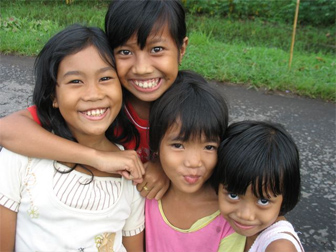
Young patients at a Clinic ASRI mobile clinic visit; these girls and their families traded manure for the organic farm, tikars (woven mats) and rainforest seedlings for their healthcare. Photo credit: Dr. Kinari Webb |
Kinari Webb: As the forest disappears throughout the world, the remaining fragments become even more important. We certainly hope that ecotourism can be developed here, but so far it is only for the very intrepid traveler as there are very few facilities available.
Carbon credit funding for ASRI's medical and conservation programs, as I mentioned above, also offer the potential of sustainable livelihoods for local communities.
There is some potential for improving local livelihoods by setting up international trade in handicrafts. HIH is experimenting a bit with that, selling colorful woven mats and baskets that ASRI patients have traded for healthcare.
Mongabay: How can people help your efforts?
Kinari Webb: The greatest way people can be of assistance would be to donate to our work financially. It costs an average of $7.00 per patient to provide comprehensive care. This includes salaries, phone bills, vehicle maintenance, rent, medicines, etc. Yet ASRI is providing discounted care to communities that protect the National Park for on average $2.50 per patient. Thus with every $4.50 you can give someone the gift of health care; in return, they will give you the gift of protecting rain forest that benefits the health of the whole planet. Information about how to contribute can be found at healthinharmony.org/help.html.
People can also help by learning more about the issues (see healthinharmony.org/media.html for recent articles about Health In Harmony's work), and the November issue of National Geographic for an article about the critical nature of forest conservation in Borneo), and through supporting Health In Harmony with contributions of skilled volunteer time and donations of medical supplies. For more information, see healthinharmony.org/help.html.
Thank you, in advance, for all of your help!
Contribute to Health In Harmony
2007 WINNER: THE AMAZON CONSERVATION TEAM
|
Help protect indigenous culture and rainforests in the Amazon
(12/11/2007) The Amazon Conservation Team (ACT) was awarded mongabay.com’s inaugural “Innovation in Conservation Award” for its path-breaking efforts to enable indigenous Amazonians to maintain ties to their history and cultural traditions while protecting their rainforest home from illegal loggers and miners. Please consider supporting the Amazon Conservation Team this holiday season. |



